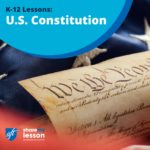C-SPAN’s Constitution Clips makes the U.S. Constitution come alive by providing teachers and students with video clips from C-SPAN’s Video Library of the Constitution in action.
Interactive Constitution: Eighth Amendment (High School)
This lesson introduces students to different viewpoints and debates surrounding the 8th Amendment by using the National Constitution Center’s Interactive Constitution. Students will build understanding of the resources and methods used by justices on the Supreme Court and Constitutional scholars when analyzing and forming opinions about articles, sections, and clauses of the Constitution
Interactive Constitution: Eighth Amendment (Middle Level)
This lesson introduces students to different viewpoints and debates surrounding the 8th Amendment by using the National Constitution Center’s Interactive Constitution. Students will build understanding of the resources and methods used by justices on the Supreme Court and Constitutional scholars when analyzing and forming opinions about articles, sections, and clauses of the Constitution.
Interactive Constitution: Fourth Amendment (High School)
This lesson introduces students to different viewpoints and debates surrounding the 4th Amendment by using the National Constitution Center’s Interactive Constitution. Students will build understanding of the resources and methods used by justices on the Supreme Court and Constitutional scholars when analyzing and forming opinions about articles, sections, and clauses of the Constitution.
Interactive Constitution: Fourth Amendment (Middle Level)
This lesson introduces students to different viewpoints and debates surrounding the 4th Amendment by using the National Constitution Center’s Interactive Constitution. Students will build understanding of the resources and methods used by justices on the Supreme Court and Constitutional scholars when analyzing and forming opinions about articles, sections, and clauses of the Constitution.
Interactive Constitution: Second Amendment (High School)
This lesson introduces students to different viewpoints and debates surrounding the 2nd Amendment by using the National Constitution Center’s Interactive Constitution. Students will build understanding of the resources and methods used by justices on the Supreme Court and Constitutional scholars when analyzing and forming opinions about articles, sections, and clauses of the Constitution.
Interactive Constitution: Second Amendment (Middle Level)
This lesson introduces students to different viewpoints and debates surrounding the 2nd Amendment by using the National Constitution Center’s Interactive Constitution. Students will build understanding of the resources and methods used by justices on the Supreme Court and Constitutional scholars when analyzing and forming opinions about articles, sections, and clauses of the Constitution.
The Constitutional Convention: To Sign or Not to Sign (Option A: The Historical Constitution)
NOTE: This lesson depends on a prior study of the Constitution Convention and the plan it produced, whether that study has been based on ConSource’s Constitutional Convention Simulation lessons or other curricula. Students will not be able to make a reasoned decision on whether to sign the Constitution unless they know what it is they are asked to endorse. Classes that have engaged in ConSource’s Constitutional Convention simulation can engage with both “To Sign or Not to Sign: Option A,” which asks students to cast a final vote on the Constitution of 1787, and “To Sign or Not to Sign: Option B,” which asks students to cast a final vote on the student-generated constitution.
Constitution Day Activities & Lesson Plans

Get ready for September 17, Constitution Day, with these preK-12 Constitution Day activities and lesson plans on the U.S. Constitution. The Share My Lesson team has selected a variety of free lesson plans, educational resources, and classroom materials to support teachers in celebrating Constitution Day with their students.
The Constitutional Convention: To Sign or Not to Sign (Option B: Student-Generated Constitution)
NOTE: This lesson is for classes that have completed other components of ConSource’s Constitutional Convention Simulation unit. Classes that have not engaged with other lessons in this unit should use Option A, in which students decide whether to sign the historical Constitution. Teachers whose classes have participated in the ConSource simulation can use either Option A, in which students decide whether to sign the historical Constitution, or Option B, in which students decide whether to sign the student-generated constitution. They can also choose to do both lessons.